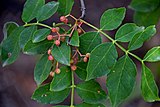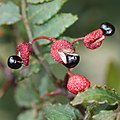Szechuan pepper
| Szechuan pepper | ||||||||||||
|---|---|---|---|---|---|---|---|---|---|---|---|---|

Zanthoxylum piperitum |
||||||||||||
| Systematics | ||||||||||||
|
||||||||||||
| Scientific name | ||||||||||||
| Zanthoxylum piperitum | ||||||||||||
| DC. |
Sichuan pepper ( Zanthoxylum piperitum ), and Japanese pepper , Chinese pepper , Chinese prickly ash , Sichuan Pepper or Anispfeffer called, is a plant from the family of the Rutaceae (Rutaceae). It provides a piquant-tasting spice and is not related to black pepper ( Piper nigrum ).
Other species of the genus Zanthoxylum also produce similar fruits, e.g. B. Zanthoxylum schinifolium , they are also sometimes called Szechuan pepper . Next are used Zanthoxylum armatum , americanum Zanthoxylum , Zanthoxylum simulans and Zanthoxylum bungeanum , acanthopodium Zanthoxylum , Zanthoxylum avicennae , nitidum Zanthoxylum and Zanthoxylum rhetsa .
The genus Zanthoxylum , to which the various species known as Szechuan pepper are counted, belongs to the Rutaceae family and is therefore related to the citrus plants ( Citrus ). The generic name can be translated as "yellow wood" and thus describes one of the characteristic features of the plants; "Yellow wood" are called different types of different genera.
The name Szechuan pepper is derived from the central Chinese province of Sichuan , where it is native and popular in the kitchen. As with the province, different spellings such as Sichuan, Sechuan or Szechuan pepper are used. In the German-speaking area, the names Bergpfeffer, Chinese pepper or Japanese pepper are also used.
description
Zanthoxylum piperitum is a very thorny shrub , it reaches heights and plant diameters of up to 2.5–4.5 meters. The alternate, stalked, imparipinnate leaves are up to 15 cm long, the individual, egg-shaped, almost sessile leaflets are 2–4 cm long, there are five to eleven pairs of leaflets. The edge of the leaflet is (distant) finely sawn to -notched, with serrated or notched points curved on the side, the point is edged or pointed to rounded, the base of the leaf is pointed to blunt. The rachis is slightly channel-shaped to short-winged, the veins of the leaflets are pinnate. The Zanthoxylum piperitum is deciduous, the autumn color is bronze. The thorns are up to 13 mm long.
Zanthoxylum piperitum is usually dioecious, separate sexes ( dioecious ), more rarely monoecious ( monoecious ) plants occur. The inflorescences are umbels , the inflorescence and flower stalks are partly reddish overflowing. The greenish-yellowish flowers appear between April and June and the light reddish, 3–5 mm large, finely humped follicles are ripe around August. They open ventrally (ventral side) and contain a round, black, shiny, 3–4 mm large seed with a spongy, soft outer seed coat . The seeds are not scattered and get stuck in the fruit bowl.
The number of chromosomes is 2n = 70.
distribution
The plant species of the genus Zanthoxylum can be found throughout Asia, but are not cultivated as useful plants everywhere. The main distribution area is mainly in the Himalayan region . Szechuan pepper is mainly used as a spice in central China , Tibet , Nepal , Japan and Korea . There are also fewer large deposits in Africa and America. Chinese names are huājiāo (花椒; flower pepper or flower pepper ), shānjiāo (山椒; mountain pepper), chuānjiāo (川椒; Sichuan pepper) or qínjiāo (秦 椒; Chinese pepper). Chinese shānjiāo is also based on the Japanese sanshō and the Korean sancho (산초) (the Korean name refers to the species Zanthoxylum schinifolium ).
use
The dried fruit peels that have been freed from the seeds are mostly used as a spice. Zanthoxylum schinifolium has aromatic seeds which are preferably used. The shells are reddish-brown or brownish to blackish in color and heavily wrinkled. Harvest time for the ripe Szechuan pepper fruits is in August, the fruits are then dried at 40 to 60 ° C. Some of the fruit peels are ground and used as a spice powder. Usually, however, the whole fruit peels are sold and only ground before the dishes are prepared.
The tingling taste, which causes a feeling of numbness on the lips and tongue, is characteristic. The substances responsible for this feeling are various amides , which make up up to three percent of the ingredients in the seed pods. Szechuan pepper is often mistakenly called spicy . This is likely due to the fact that it is often used in dishes that also contain hot peppers . In Chinese, the flavor that is created by combining Szechuan pepper and hot paprika is called málà (麻 辣) d. H. "Numbing and sharp". This flavor gives the Sichuan cuisine its independent character. Representative dishes include the hot pot ( chinese 火鍋 / 火锅 , Pinyin Huǒguō ), Dandan Mian ( 担担面 , Dandan Mian , noodles with spicy sauce), spicy beef ( 水煮牛肉 , Shuǐ zhǔ niurou ) and Mapo Doufu ( 麻婆豆腐 , Má Pó Dòufǔ , tofu with minced meat). Szechuan pepper is also part of the five-spice powder mix .
Unripe fruits, leaves and flowers of the plant are mainly used in Japanese cuisine . The young and fresh leaves are soaked and mixed with miso paste called kinome (木 の 芽). Kinome is often used as a garnish on soups and other dishes. For the seasoning paste Misansho , unripe fruits are boiled down with salt. This paste is mainly used for the preparation of fish in order to reduce the possibly unpleasant fish odor.
Szechuan pepper is also used in traditional Chinese medicine . In Germany, the plant is also sold designed as a bonsai . Antioxidants have been found in seeds, fruits and leaves of the species .
Ban on imports into the USA
From 1968 to 2005 the import of Szechuan pepper into the USA was banned by the Food and Drug Administration (FDA). In this way, the further spread of a bacterial infection of citrus fruits ( lemon cancer ) should be slowed down. This should prevent the occurrence of new pathogen variants. Since lemon cancer cannot be treated so far and thus threatens the citrus and orange industries in Florida, an outbreak of the infection would be fatal for the local economy. In 2005, the restrictions imposed by the FDA and the United States Department of Agriculture (USDA) were relaxed, so that Szechuan pepper, which was heated to around 70 ° C, can be imported into the USA again.
See also
Web links
- Gernot Katzer's spice pages .
- Botanical and common names in many languages for the genus Zanthoxylum .
Individual evidence
- ^ Zanthoxylum piperitum at Oregon State Univ., Accessed December 15, 2017.
- ↑ Eduard Winkler : Complete Real-Lexikon der medicinisch-pharmaceutischen natural history. Volume 2: M – Z , Brockhaus, 1842, p. 922, limited preview in the Google book search.
- ↑ Zanthoxylum in the Flora of China, Vol. 11, p. 52 f.
- ↑ Zanthoxylum piperitum at Tropicos.org. In: IPCN Chromosome Reports . Missouri Botanical Garden, St. Louis
- ↑ E. Hisatomi, M. Matsui, A. Kobayashi, K. Kubota: Antioxidative Activity in the Pericaprp and Seed of Japanese Pepper (Zanthoxylum piperitum DC). In: Journal of Agricultural and Food Chemistry. 48, 2000, pp. 4924-4928.
- ↑ Denise Landis: Sichuan's Signature Fire Is Going Out. Or is it? In: The New York Times . February 4, 2004, p. F1 , accessed May 8, 2017 .
- ↑ Sichua Pepper Properties on Botanical Online (Eng.)





